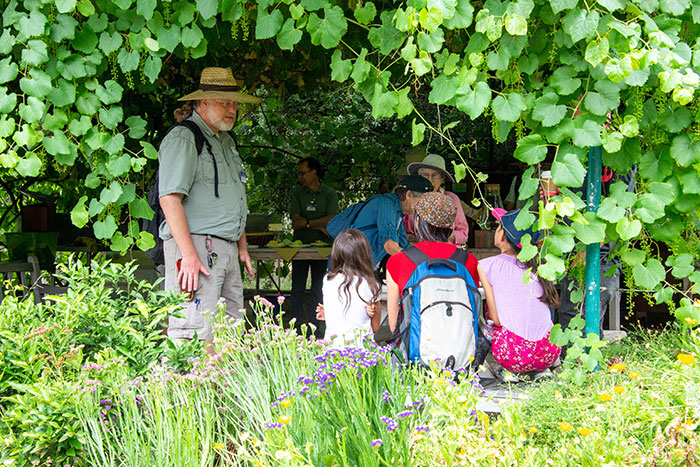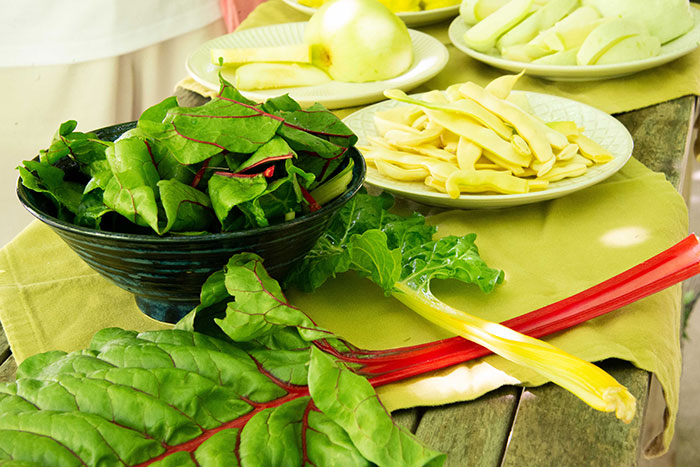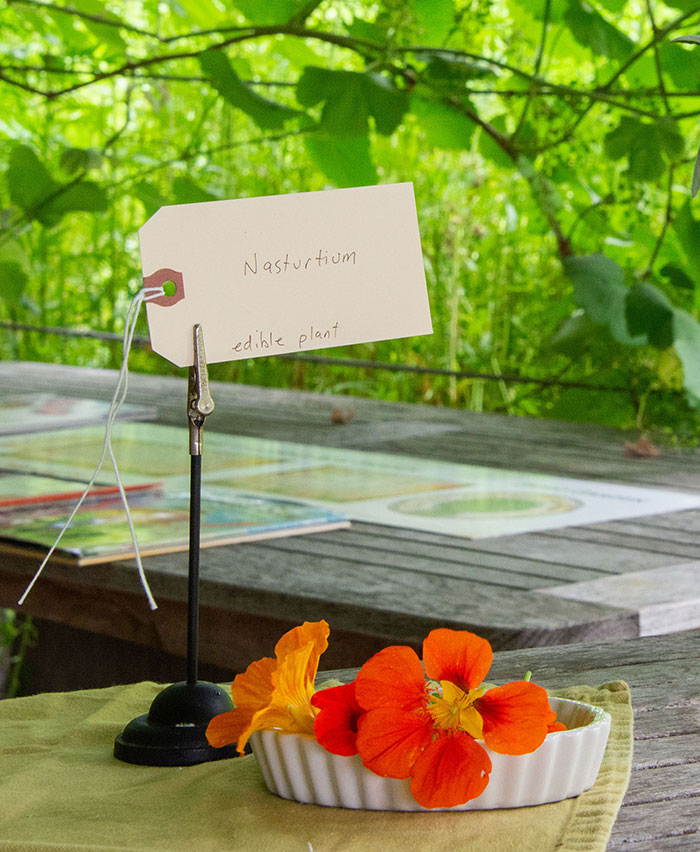The blog of The Huntington Library, Art Museum, and Botanical Gardens.
Master Gardeners at the Ranch
Posted on Wed., July 11, 2018 by

Master gardener volunteer Roger Gray talks with children during a recent Saturday open house at The Huntington’s Ranch Garden. Photo by Deborah Miller.
The master gardeners who volunteer each Saturday at the Huntington Ranch Garden Open House are the perfect hosts for this one-of-a-kind garden experience. They always arrive early to harvest the freshest seasonal bounty from the vegetable beds and fruit trees and set out samples for visitors to taste. When the garden’s wooden gate swings open at 10 a.m., they cheerfully give tours of the 15-acre site and offer their considerable knowledge on every gardening topic under the sun.
The Ranch Open House, held each Saturday from 10 a.m. to 1 p.m., is an open invitation for the public to gather fresh ideas for sustainable gardening and sample seasonal fruits and vegetables culled from the garden’s edible landscapes. Participants in the UC Master Gardener Program are citizen volunteers who have completed an intensive, three-month training program facilitated by the UC Cooperative Extension and then work to promote environmentally responsible and sustainable horticultural practices in home, community, and school landscapes.
Master gardeners appear as natural in The Huntington’s experimental Ranch Garden as bees do on a sunflower.

Master gardeners arrive early on Saturdays to harvest the freshest seasonal bounty from the vegetable beds at the Ranch Garden and set out samples for visitors to taste. Photo by Deborah Miller.
One recent Saturday, a master gardener volunteer gleefully clutched a bunch of golden carrots that were just moments earlier pulled from the soil. He washed, chopped, and served them alongside bowls of sweet blueberries and Gold Kist apricots. Another volunteer offered fresh Swiss chard and kale to a group of young children.
Mark Swicegood, a master gardener since 2004 who has logged more than 1,000 volunteer hours, guided me through the urban agricultural oasis of fruit trees interspersed with native shrubs, crop beds, perennial herbs, and wildflowers. Around us artichokes flourished, some with leaves still closed while others displayed their fuzzy purple flowers. “Artichokes are perennial plants, so let them die down but don’t pull them out, and they will come back next year,” he advised, adding that a healthy plant can produce edible flower buds for many years.
As we walked, he pointed out winter spinach and kohlrabi and a Golden Dorsett apple tree whose branches had been espaliered against a fence to conserve space. The lizards, birds, butterflies, and dragonflies that scurried and fluttered about indicated the garden’s emphasis on nurturing habitats that support wildlife and pollinators.

Mark Swicegood, a master gardener since 2004, talks to visitors at the Ranch Garden. Photo by Deborah Miller.
Later, as I sat at a picnic table in the garden’s heart (often the spot of many engaging gardening conversations), master gardener Aaron Ostrom explained how daikon radishes can serve as natural rototillers in clayey or compacted soil. “As they grow, their roots tunnel through the soil, and when they rot, they leave behind a wonderful tube,” he said. The plant’s decaying organic matter also helps to nourish the soil.
The practice of using daikon radishes for this purpose had been employed at the Ranch back when it was first being developed more than a decade ago when the land was used as a parking lot during the construction of the Chinese Garden.
“Visiting the Ranch gives people a way to see how things grow at various stages and to decide if it’s something they want at home, pointed out Ostrom. “A lot of gardening is problem-solving and experimenting.”
I realized I had found botanical nirvana. If I hung around the Ranch long enough, my brown thumb might turn a shade of green, and I could picture myself at home wielding a spade.

At the Ranch garden, you can even taste some of the flowers, including this peppery nasturtium. Photo by Deborah Miller.
“The master gardeners don’t do any actual gardening at the Ranch,” said Jim Folsom, the Marge and Sherm Telleen/Marion and Earle Jorgensen Director of the Botanical Gardens. “Rather, they are the garden’s guardian angels, tasked with interpreting the site and answering questions from the public.”
Folsom thought of bringing in master gardeners when he was searching for a way to keep the Ranch open more than just one day a month, as it had previously been. For the past 20 years, Folsom has taught the botany portion of the UC Master Gardener Program class and was well acquainted with Rachel Surls, who directs the Los Angeles County Master Gardener Program.
“We're happy that master gardeners can help make sure the Ranch is open to the public, and at the same time fulfill our mission of teaching sustainable gardening,” said Surls. “The Ranch is full of great examples of techniques and plants that are perfect for local gardens, whether in a backyard, at a school, or on a balcony.”
The master gardeners also run a popular clinic series at The Huntington several times a year at which they will discuss such topics as composting, container gardening, and canning. On August 25 at 9 a.m., master gardener Roger Gray will lead an informational and planning workshop to help extend the life of your home food garden well into the fall.
You can read more about the Ranch garden in the online Fall/Winter 2017 issue of Huntington Frontiers.
Manuela Gomez Rhine is a freelance journalist based in Pasadena, California.